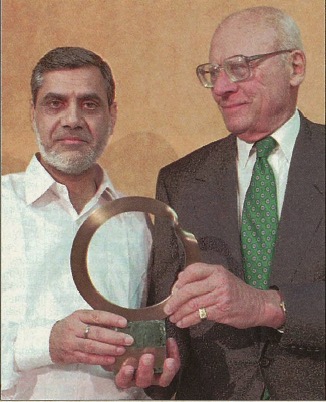New Delhi attorney M.C. Mehta has successfully argued before India’ Supreme Court that pollution as a hazard to life is a violation of every Indian’s constitutionally guaranteed “Right to Life.” The court has consequently intervened directly, issuing sweeping judgments closing industries and demanding others meet exacting standards. Mehta talks about his passion in interviews with the Multinational Monitor and Hinduism Today Delhi correspondent, Rajiv Malik.
Why he got involved
In 1985, I learned that the Ganga caught fire near Haridwar, one of the holiest pilgrim centers in India. The effluents from two factories were so toxic that in 1984 somebody put a lit match into the river by chance and a whole one-kilometer stretch caught fire. The fire went 20 feet high and could not be extinguished for three hours. I learned that there were many people who had become sick from the water. I filed a petition in the Supreme Court of India in 1985 against these two polluting factories. The scope of the case has now been broadened to include all the industries and all the municipal towns in the river basin–from the beginning to the end of the Ganga. The court has directed more than 5,000 factories to install air and water pollution control devices. In the last few years, the Court has even ordered factories to close until they install pollution control devices and meet prescribed standards.
The “Right to Life” provision
In India, we are fortunate that Article 21 of the Indian Constitution gives the “Right to Life.” The Supreme Court has broadened the scope of this Right to Life to include the right to live in a healthy environment. If I am breathing unclean air, or drinking contaminated water, I cannot live a healthy life. Pollution is thus a threat to life. And if there is a threat to life, a citizen can go to court and file a petition. Many parts of the Ganga river are totally dead; the water is so polluted that it is unfit for drinking, washing, bathing or irrigational purposes. Thirty percent of the Ganga pollution is being caused by industry. Seventy percent is caused by cities and towns which discharge domestic waste straight into the Ganga. The municipal bodies say that they do not have money to treat the waste, and you can’t close down a city.
The Ganga Action Plan
Soon after the filing of the case, the Government of India initiated a Ganga Action Plan to clean the Ganga river. The Plan has been a complete failure. It did not yield any results. Rs.500 crore (US$142 million) has gone down the drain. No program of cleaning Ganga can be successful if the participation of the people is not there.
The saints must help
Ganga is the holiest of holy rivers, and every Hindu has a deep reverence for it and is ready to do his bit in a “Clean Ganga” project–provided there are the right kind of people who can inspire the people at large. Presently, religious organizations and spiritual people are not working in an organized manner. The saints and spiritual leaders who go and have a bath in Ganga must know that Ganga’s water is totally unfit for washing, bathing, drinking and irrigation purposes. If we believe that Ganga is our mother, how can we let our mother not be clean? It is nothing less than a sacrilege the way the Ganga is today.
An all-India crisis
India is suffering from an environmental crisis. Now is the time to save the country. We should learn lessons from the Western countries, and not repeat their mistakes. We should control pollution at the source, so that problems don’t emerge later on. Indian rivers and lakes are polluted, and groundwater sources in many places have become highly contaminated.
Beware the multinationals
The multinationals which are now coming to this country are behaving atrociously. When they are in the United States, Germany or any other Western country, they observe the laws. But once they come over here, they pollute and ignore all laws. If these multinationals are polluting in this country, the NGOs [non-governmental organizations]–like Greenpeace and others–should pressure them in their home countries. That is the only way that they won’t pollute. Development should take place. But development should not take place at the cost of human suffering and human life.
His Ganga Action Plan
Two groups should be formed to carry on the work, one at the international level and the other at the national level. These two groups can be formed as nucleus groups comprising three to five people. But these few people should be people of great integrity and commitment. If one model city is created, others can follow suit. If I can be of any help to anyone please contact me.
M.C. Mehta, 5, Anandlok, Khelgaon Marg, New Delhi, 110 049, India.
